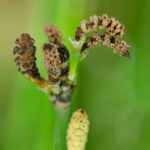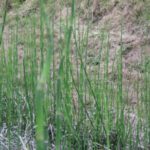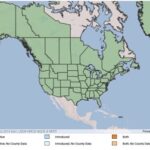Equisetum hyemale
Illustration courtesy of University of Florida/IFAS Center for Aquatic and Invasive Plants. Used with permission.
What is Horsetail?
Physical Characteristics
Sheaths:
- Cylindrical
- Usually has black band at base
- Central portion whitish-gray to pinkish in color
- Has ridges
- 0.2-0.47 inches long
Fruit:
- Egg-shaped cones
- 0.5-1 inches long
- 0.2-0.39 inches in diameter
Stem:
- Slender rhizome
- Blackish in color
Upright Stems:
- Evergreen
- Standing alone
- Many ridges
- Up to 9 feet tall & 1 inch in diameter
Branches:
- Similar to primary stems, but smaller in size
Where Does it Grow?
USDA, NRCS. The PLANTS Database (http://plants.usda.gov). National Plant Data Team, Greensboro, NC 27401-4901 USA.
Horsetail can be found in sandy or loamy soil in open or wooded areas along streams and flats, in seepage, and on wet ledges.
Pros and Cons of Horsetail
Horsetail has no known direct food value to wildlife. Submerged portions of all aquatic plants provide habitats for many micro and macro invertebrates. These invertebrates in turn are used as food by fish and other wildlife species (e.g. amphibians, reptiles, ducks, etc.). After aquatic plants die, their decomposition by bacteria and fungi provides food (called “detritus”) for many aquatic invertebrates.







